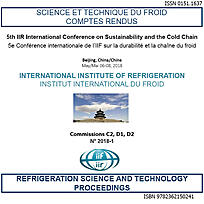
Résumé
High and low temperature levels are using R410A as refrigerant, and expansion of the containers and other devices do not need to set in flow single-refrigerant cascade refrigeration system. It makes system structure is more simple.The refrigerant flow can be controlled by the frequency of compressor in this refrigeration system.Study and analyze the effect of evaporation temperature incremental and high temperature compressor frequency incremental on system performance.The flow ratio decreases and COP increases with evaporation temperature increases when condensation temperature is constant in the cascade refrigeration system. The maximum flow ratio of the high temperature level decreased by 0.071% and the flow ratio of the low temperature level increased by 0.27% when the evaporation temperature increased by 1K. Meanwhile the flow ratio decreased by about 1.36%, and the interstage capacity ratio increased by 1.5%, and the COP maximum increased by 3.76%. And the interstage capacity ratio maximum decreased by 2.62% when the frequency of compressor increased by 1Hz. Through changing the frequency of compressor, the energy consumption can be reduced. And the COP can be improved and the system is more energy efficient.
Documents disponibles
Format PDF
Pages : 8
Disponible
Prix public
20 €
Prix membre*
Gratuit
* meilleur tarif applicable selon le type d'adhésion (voir le détail des avantages des adhésions individuelles et collectives)
Détails
- Titre original : Experimental study on single-refrigerant cascade refrigeration system.
- Identifiant de la fiche : 30023398
- Langues : Anglais
- Source : 5th IIR International Conference on Sustainability and the Cold Chain. Proceedings: Beijing, Chine, 6-8 avril 2018
- Date d'édition : 06/04/2018
- DOI : http://dx.doi.org/10.18462/iir.iccc.2018.0044
Liens
Voir d'autres communications du même compte rendu (72)
Voir le compte rendu de la conférence
Indexation
-
Thèmes :
Systèmes à compression;
HFC - Mots-clés : Système frigorifique; R410A; Température; Performance; Système en cascade; Évaporation; Essai; COP
-
Miscele di CO2 + HFC per cicli in cascata opera...
- Auteurs : DI NICOLA G., GIULIANI G., POLONARA F., et al.
- Date : 27/06/2003
- Langues : Italien
- Source : Le ultime tecnologie del freddo e del condizionamento [+ annex, videolezione and CD-ROM]./ Technological innovations in refrigeration and air conditioning [+ annex, video and CD-ROM].
Voir la fiche
-
Experimental evaluation of a cascade refrigerat...
- Auteurs : SOUZA L., ANTUNES A., MENDOZA O., et al.
- Date : 16/08/2015
- Langues : Anglais
- Source : Proceedings of the 24th IIR International Congress of Refrigeration: Yokohama, Japan, August 16-22, 2015.
- Formats : PDF
Voir la fiche
-
Thermodynamic analysis of a CO2-NH3 cascade ref...
- Auteurs : DOPAZO A., FERNÁNDEZ-SEARA J., ARIAS A., et al.
- Date : 21/08/2007
- Langues : Anglais
- Source : ICR 2007. Refrigeration Creates the Future. Proceedings of the 22nd IIR International Congress of Refrigeration.
- Formats : PDF
Voir la fiche
-
Development and performance analysis of a multi...
- Auteurs : LIANG Y., LI H. Q., WANG D., et al.
- Date : 12/07/2010
- Langues : Anglais
- Source : 2010 Purdue Conferences. 13th International Refrigeration and Air-Conditioning Conference at Purdue.
- Formats : PDF
Voir la fiche
-
Research on the inner cycle on the auto-cascade...
- Auteurs : ZHANG S. Q., DU K., WANG Z. L., et al.
- Date : 21/08/2007
- Langues : Anglais
- Source : ICR 2007. Refrigeration Creates the Future. Proceedings of the 22nd IIR International Congress of Refrigeration.
- Formats : PDF
Voir la fiche
